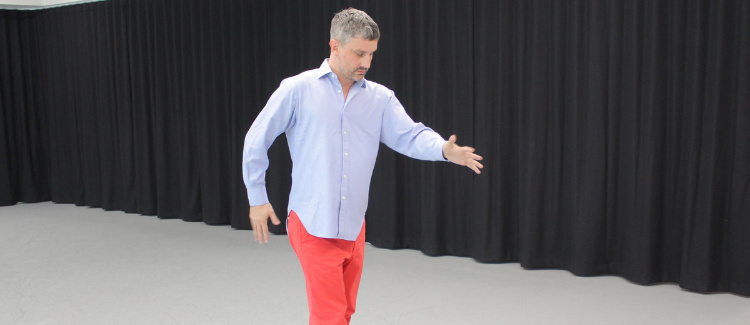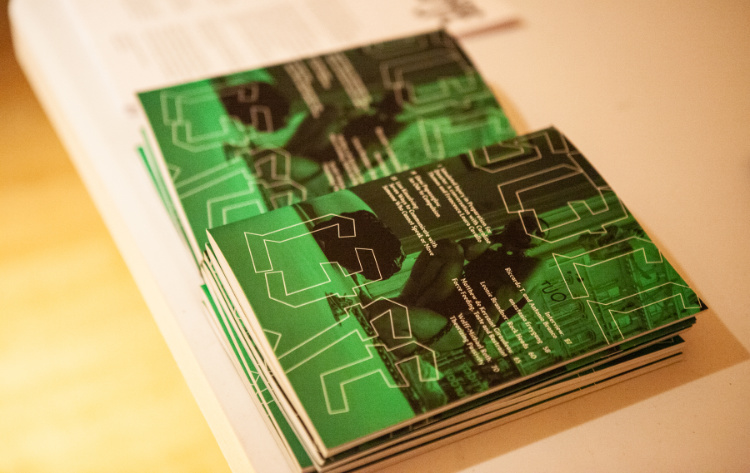
Hamish MacPherson is a choreographer who creates environments for people to think, learn and be together. He is inspired by care ethical theory and his zine ‘STILL LIFE‘ is one way to contribute to these kinds of environments. ((A zine is a noncommercial often homemade or online publication usually devoted to specialized and often unconventional subject matter. Source)) Reading the zine made me reconsider movement and silence in everyday life.
As a former dancer and a graduate of the Master Care Ethics myself, I am struck by the link between living in a society and movement, or being still. About the contribution that thinking about this topic could make to care ethical theory. Because of the relevance of the topics in MacPherson’s zine to care ethics, I wanted to know more about his ideas and motivations for this magazine. So I asked Hamish MacPherson some questions.
STILL LIFE
First of all, I would like to know what your mainspring is for making the zine. Can you tell me something about that?
Hamish MacPherson: The zine STILL LIFE is part of a wider project called Configurations through which I have made performances and workshops.
I am interested in thinking about care as an aesthetic, choreographic and political practice. As a negotiation of constantly fluctuating needs, capacities and interests. I am particularly interested in care that is disengaged, hostile, reluctant or otherwise complicated and problematic. Through this research I am examining the physical performances of care calling on knowledge from somatic dance, nursing and kink. As a thread to connect them I am looking at how people care for still, passive bodies.
I am approaching this research with the idea of ‘configurations’. These could refer to arrangements of elements in particular forms. Or (in computing) to configuration files which create the initial settings for a computer programs. Sometimes it provides tools to modify those settings.
Rather than explicitly try to make work ‘about’ care (which is quite a popular subject in performance and art at the moment) or care ethics (which risks becoming illustrative) or that even uses the word care (which is loaded) I wanted to use this passive-active configuration as a sort of physical question that could have its own logic. It is a configuration that occurs in many conventional care settings but also less obvious ones. It reveals a kind of dependency or need (which could be voluntary or involuntary) and responsibility that seems to be at the heart of care ethics.
Reasons
What are the reasons for making this zine?
Hamish MacPherson: There are a number of reasons for making a zine:
- It is something I can do without institutional support
to continue my research. I don’t need rehearsal space or funding etc. - It hopefully allows me to reach people who wouldn’t want or be able to come to a performance or workshop. And so allows the research to hopefully find more interlocutors.
- In particular my hope was that since the different subjects are quite clear (performance, healthcare, kink) I had hoped that people from these worlds might be interested in one interview or article and then learn about another.
- Whereas the more practical, workshop/performance ‘outputs’ deal with the situation that they are in (i.e. they are not representational or about care work), the zine allows me to make connections with the wider world and different situations.
Practical knowledge
What I like is that (in my opinion) you are studying bodiliness and movement by describing and explaining what it is. But not in a mainstream scientific way. I think you approach what you are studying more on the level of exploring. Specifically from the standpoint of experience of people. Is this correct and why do you do this?
Hamish MacPherson: I am interested in different kinds of practical knowledge that people have about bodies (their own and others) and movement. This is what interests me about choreography and how this knowledge interacts, supports, challenges, critiques, theoretical, language-based knowledge. And in particular this is what I think choreography can offer to care ethics as a field which, while acknowledging the particular, embedded, embodied nature of ethics, still works with the traditional abstracted format of language.
And it’s not just choreography that has this practical knowledge. I’m interested in revealing care as a practice that manifests throughout life. Interviews I think, are a good way of sticking to the practice and not getting too caught up in analysis. And yet by putting different types of accounts together in an issue I am inviting the reader to make connections between practices and understand them in new ways.
One still and one active person
I think the subjects in the articles are close to art, because you interview artists about parts of their art or their performance. I am wondering about what your starting point is. Is it art, is it bodiliness and movement or is it care?
Hamish MacPherson: I don’t think it’s mostly about art but interesting that you read it that way. Many of the people I have spoken to about non-art things have been artists because these are the networks I have been in. These are the people who have been most receptive to the concept. Maybe that’s why you got the impression. The starting point is always the configuration of one still and one active person.

Call out
I am very curious of how you find the topics for the zine. Can you tell me something about that?
Hamish MacPherson: Earlier this year [2018] I had a call out for people to submit content on the theme which opened up the forms and the approaches to the theme. But before that I had been working and thinking with this passive/still-active arrangement for a year or two so. I had been collecting in my head different scenarios, situations, performances and occupations where this occurs.
When I decided to make the blog I then went about asking people if I could interview them or sometimes whether I could use already written content. I had also been collecting images of situations which was part of the research. Also I found people I knew already, that friends told me about, and that I found online for example on Twitter or Instagram or blogs.
Although direct approaches worked best, I posted call outs on Facebook groups and other interest groups. The list is quite broad but is mostly a mix of choreography/performance, health care and BDSM. (Which is a range of practices that deal with care in interesting ways). The relationship to the theme has sometimes become a bit less direct in later issues, but I think that enriches the question.
Care-ethicists
Are you inspired by specific care-ethicists? Can you name them and explain why?
Hamish MacPherson: I have been inspired by Virginia Held. I specifically found her book “Ethics of Care” to give a good summary of the field of care-ethics. Joan Tronto I like for positioning care as a political foundation and not just something that relates to traditionally conceived social area.
I think ‘Towards an Aesthetics of Care’ by Josephine Donovan is the most important book so far regarding the relationship between aesthetics and ethics and pointing towards what an aesthetics of care might be.
Care as an aesthetic,choreographic and political practice
Hamish MacPherson
Art and care
Speaking of art: do you have an opinion about what art is? After a few years studying at a dance academy I got my Master’s degree Arts and Culture Studies at the Erasmus University in Rotterdam. As a result I am always wondering about what art is and why. I just got my Master’s degree in Care Ethics at the University of Humanistic Studies. And now I am also wondering about the relation between art and care ethics. Do you have any insight about art, care and ethics you can share?
Hamish MacPherson: I don’t think I’d want to get into a definition of what art is; I’m not sure if I can or whether this really interests me. Different groups, times, places will define it or think of it in different ways and that is the way language works.
There is lots of art at the moment about care; about self-care and about the therapeutic potential of art. But I am not so much interested in this at the moment. Although these are important and reveal the ability of art activity (whether it is dance or other things) to involve and manifest caring relationships.
Relationships
Hamish MacPherson: I think I’m more interested in the relationship between choreography and care ethics as a field. Can it be a way to think about care ethics in critical ways? And can it problematize care ethics which seeks to examine ethics as something particular, relational, embedded and embodied. Yet it is generally limited to language as its medium. Can embodied practices slightly outside (a claim that is questionable itself) of traditionally recognised care practices give us space to think about care?
Donovan, who I mentioned before, also starts us thinking about what the relationship between art and care ethics might be. Her point as I understand it is that western aesthetics have followed western ethics in seeking to rationally understand, or capture the world. But what might an aesthetics be that puts the relationships between beings first? In my own work: what might a performance be that puts the relationship performers and with audiences at the forefront rather than something like elegance or minimalism or simplicity or uniformity?
This is not a new discussion in art theory but perhaps framing it in care ethics is. This is really something I want to research more but this is kind of where I am at the moment. In my latest performance (also called Still Life) for example which works with different forms of passivity and activity. I was interested in it being too long for the audience to see the whole work and so they could only see a part of the whole. And another audience would see another section. This arrangement was also inspired by the shift patterns of nurses who hand over responsibility of patients or more globally how we pass on responsibility for the planet.
About the zine
If you want to read the zine for yourself: ‘STILL LIFE‘ is available online and in print. www.hamishmacpherson.co.uk
Headerimage: Photo by Nick Quinn

0 reacties